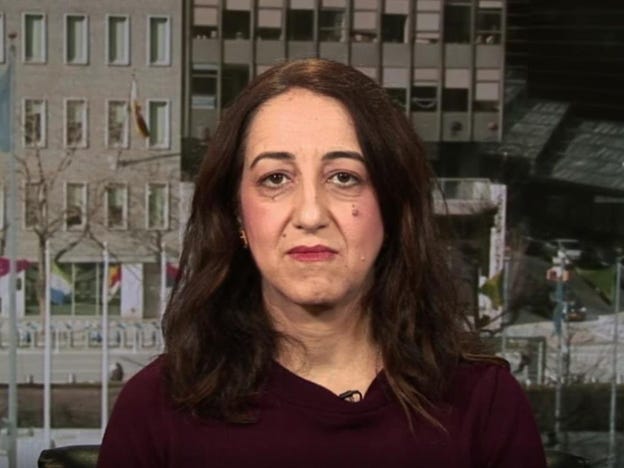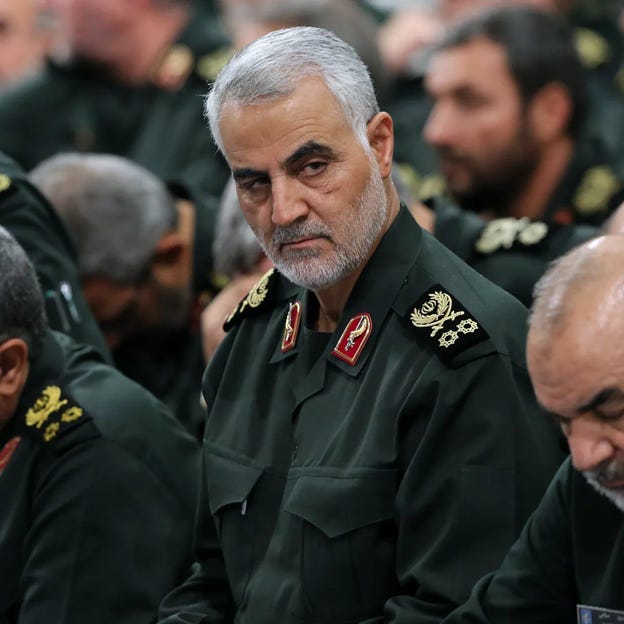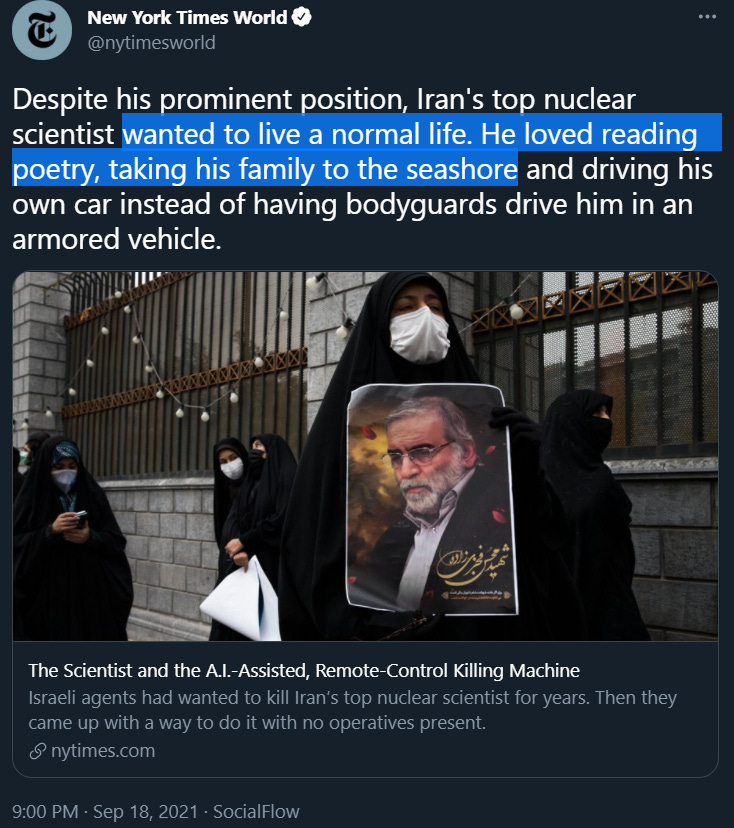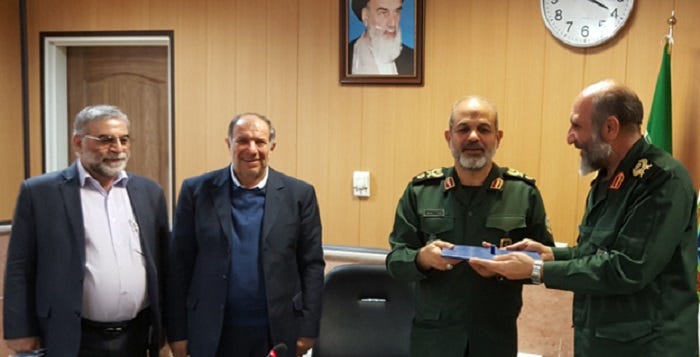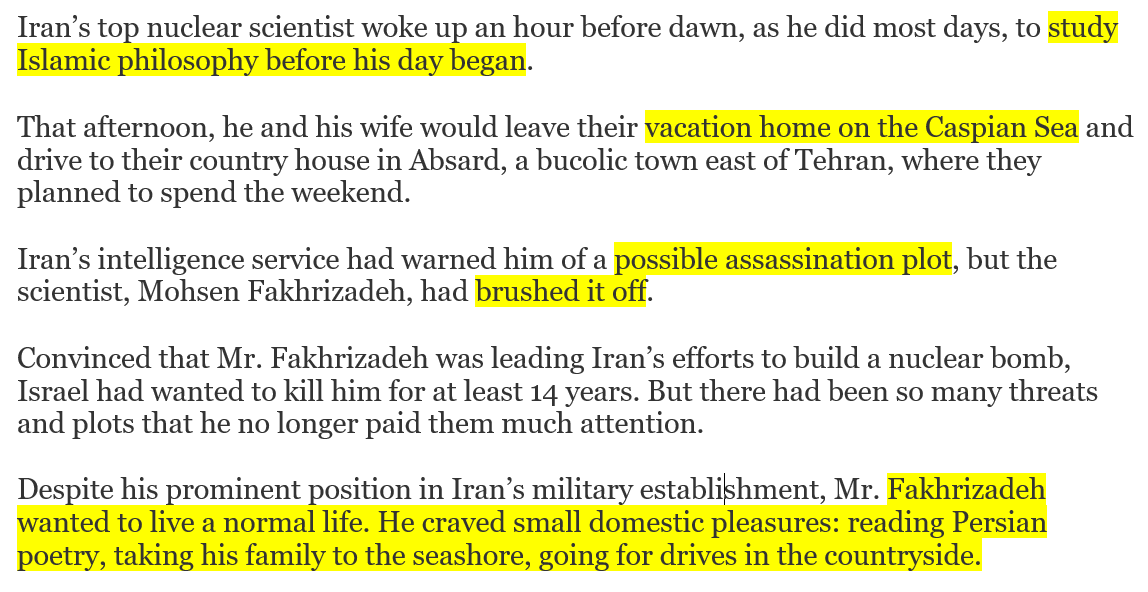Who is Farnaz Fassihi?
Farnaz Fassihi is a writer in The New York Times and formerly wrote for The Wall Street Journal. She is an Iranian American heavily criticized for parroting the talking points of Iran’s regime.
In her NYT articles she has described Qassem Soleimani as a “popular general” and “universally admired.” Soleimani, killed by a U.S. drone strike on January 3, 2020, was the head of the regime’s Revolutionary Guards (IRGC) Quds Force in charge of the mullahs’ extraterritorial terrorist attacks. He was best known for his close contact with the Hezbollah in Lebanon, Iraqi militia groups, and others in Iran’s proxy war against the U.S. and its allies across the region. Soleimani’s campaigns in Syria, Iraq, Lebanon, Yemen, and Palestine has left millions of people either dead, injured, or displaced inside their country or forced to flee abroad.
Fassihi has more recently whitewashed the image of Mohsen Fakhrizadeh, Iran’s nuclear weapons mastermind killed in a mysterious attack on November 27, 2020. Co-writing another NYT piece, Fassihi says Fakhrizadeh “wanted to live a normal life. He craved small domestic pleasures: reading Persian poetry, taking his family to the seashore, going for drives in the countryside.”
Here’s something interesting Farnaz Fassihi will not tell NYT’s readers:
“If Iran ever chose to weaponize [enrichment], Fakhrizadeh would be known as the father of the Iranian bomb,” a Western diplomat told the Reuters news agency four years ago. He has often been compared with Robert Oppenheimer, the director of the American nuclear development program in the 1940s, according to the Times of Israel.
On October 16, 2020, the Iranian opposition coalition NCRI held a press conference in Washington, DC, to reveal their newly obtained information about Iran’s nuclear weapons program and Fakhrizadeh.
“According to top-secret intelligence obtained by the network inside Iran of the People’s Mojahedin Organization of Iran, (PMOI/MEK) from within the regime, SPND has continued its work following the JCPOA. The structure and the personnel of SPND remain intact and part of the institution has been expanded. Brig. Gen. Mohsen Fakhrizadeh Mahabadi continues to remain the head of this organ. Thus, the JCOPA notwithstanding, the Ministry of Defense and the IRGC have maintained their capabilities to build a nuclear weapon,” said NCRI-US office deputy director Alireza Jafarzadeh.
Glorification of Qassem Soleimani
Now that we are fully acquainted with both Soleimani and Fakhrizadeh, let us dig into how Farnaz Fassihi whitewashes their images, and why, as result, she is described by many as an Iran apologist.
To back her argument of Soleimani enjoying enormous popularity in Iran, Fassihi claimed: “A crowd of people stretching over 30 kilometers, or about 20 miles, poured into the streets of Ahvaz, Iran” to mourn Soleimani’s death.
The regime’s state media in Iran was quick to pick up Fassihi’s reporting as global recognition of Soleimani’s domestic popularity.
To be fair, here’s the footage. At first, one thinks: OMG!

This is the longest distance filmed from above, clearly showing the beginning and the end of the crowd. The entire distance is 1.5 km. All the while, Fassihi publishes a lie in The New York Times: “over 30 kilometers”
Here are three images from a research on crowd calculation. There are two people per square meter. In many marches where people are seen to be shoulder to shoulder, they are calculated as 2/sq. meter.
The footage we saw was similar. Now we need to calculate the distance to reach the number of people attending this march. The crowd began at the Naderi Medical Complex, continued after a few intersections/squares, and reached a bridge. The bridge was full of people and afterwards they reached the Moulavi Square. The crowd continued for a few squares afterwards.
Following final calculations, the crowd area stood at 45,770 square meters. Considering the crowd at two per square meter, the total number of people was around 91,540.
In dictatorships that use all their national assets to maintain their rule, you can never estimate the true honesty of “popular support.”



From now on, whenever people show you such footage and make remarks about “million man” marches supporting a certain state, especially dictatorships, remember these calculations and have a good laugh. Such street carnivals are old tactics used by dictators. And dictators can always count on mainstream media to spread their fake news.
While Fassihi describes Soliemani as a “popular general” in her NYT piece, watch this Iranian family dance in their home after hearing about the "terrorist Soleimani's" death.


This is how NYT and Fassihi literally romanticize a mass murder who led the killing of hundreds of thousands of innocent people in Iran, Iraq, Syria and …
“Iran’s Intrigue”
Normalizing Mohsen Fakhrizadeh
As mentioned before, Mohsen Fakhrizadeh was the mastermind behind Iran’s drive to obtain nuclear weapons. You can also describe him as the Iranian regime’s Abdul Qadir Khan, the father of Pakistan’s atomic bomb.
In her latest co-written NYT piece, Fassihi is quite careful about how the article begins to image Fakhrizadeh as “just another guy” in the reader’s mind.
Fassihi says this new NYT piece confirming Fakhrizadeh was killed on November 27, 2020, supposedly by a robot sniper with artificial intelligence controlled from thousands of kilometers away was written following interviews with “American, Israeli and Iranian officials, including two intelligence officials familiar with the details of the planning and execution of the operation.”
This is quite revealing. Why? The Iranian regime only provides interviews with its officials, especially intelligence officials, to those foreign-based reporters that are considered completely trustworthy by the mullahs’ vast security apparatus. The fact that Fassihi has been provided access to “Iranian officials, including two intelligence officials,” is quite telling.
Also interesting is how Fassihi’s other sources are all focused on the regime’s state-run media. Mehr News is affiliated to Iranian Intelligence Ministry and Fars News to the IRGC. Gheish Ghoreishi, another Fassihi source, had advised Iran’s Foreign Ministry on Arab affairs, meaning the regime’s meddling in the Middle East through supporting terrorist groups. Finally, Ali Shamkhani is the secretary of Iran’s Supreme National Security Council, and rest assured Fassihi deliberately omitted the word “security” in his title.
Here’s another attempt by Fassihi to normalize Fakhrizadeh’s image:
“The operation’s success was the result of many factors: serious security failures by Iran’s Revolutionary Guards, extensive planning and surveillance by the Mossad, and an insouciance bordering on fatalism on the part of Mr. Fakhrizadeh.”
She seeks to portray Fakhrizadeh as another normal person who has lived a long life and is not afraid of destiny. This would play into the sought image of Fakhrizadeh not being the all important mastermind of Iran’s nuclear weapons program.
And we have Fakhrizadeh, the dedicated professor loyal to his students.
Here we have Fassihi portraying Fakhrizadeh as just another guy who loves cars and is a loyal, caretaking husband.
Fassihi goes on to portray Fakhrizadeh as a man working for Iran’s development. This signals further effort to distance the reader from any thought of Fakhrizadeh seeking nuclear weapons for the mullahs’ regime.
Fassihi and bailing out Iran’s regime
This NYT reporter is also active in pushing Iran’s talking points. Here’s one example to deny the regime’s pursuit of nuclear weapons:
“Iran has steadfastly insisted that its nuclear program was for purely peaceful purposes and that it had no interest in developing a bomb. Ayatollah Khamenei had even issued an edict declaring that such a weapon would violate Islamic law.”
In one segment of the article Fassihi resorts to a lie hoping no Western reader would have the knowledge or be keen to conduct any research.
“Israel had used a variety of methods in the earlier assassinations. The first nuclear scientist on the list was poisoned in 2007. The second, in 2010, was killed by a remotely detonated bomb attached to a motorcycle, but the planning had been excruciatingly complex, and an Iranian suspect was caught. He confessed and was executed.”
This Iranian suspect is Majid Jamali Fashi, executed in Tehran at the age of 24. It was later revealed that regime authorities forged a passport for Fashi to justify his execution.
But the emergence of the passport has increased suspicions that Mr Fashi was a scapegoat for the killing, while many opposition activists remain convinced that his execution was an elaborate hoax.
Fassihi’s track record
While Fassihi and NYT have published this report about Fakhrizadeh’s assassination plot, there are a few issues regarding the entire scenario raised in this publication. Keep in mind that the regime would prefer Fassihi’s report in the NYT bought as the events of that day to therefore quickly dismiss any thought of assassins actually being on the ground and at the very scene, which would be far more embarrassing.
With that in mind, I ask you to read this thread explaining my take on the events of that day:


On July 2, 2020, a mysterious explosion rocked the highly sensitive Natanz enrichment site in central Iran. There have been no confirmed reports of what caused the massive blast that took out an importance facility in advanced centrifuge research and development that would allow the regime to enrich uranium at much higher speeds.
The regime has gone to great lengths in denying any possibility of an airstrike, knowing how humiliating that would be. For those interested, this thread breaks down available information from various on-the-ground and satellite images from the site, and compiles the analysis of various experts in this field to show that not only the regime is lying, but also concealing information they consider extremely dire.

A look at Fassihi’s track record proves she is anything but an independent and unbiased journalist. Instead, she carefully treks along the lines of the Iranian regime’s interests:
- quickly questioned reports from Reuters and the U.S. State Department on the Iranian regime killing over 1,500 protesters during the November 2019 nationwide protests
- blamed U.S. sanctions while Iranians in the southwest provinces were protesting severe water shortages caused by the regime’s corruption and mismanagement
- pushed the regime’s talking points following the execution of Ruhollah Zam, effectively justifying the mullahs’ human rights violations
- glorifies life in Iran by emphasizing on certain areas prepared by the regime, gaslighting a “normal life” to distract attention away from reports of the Iranian people’s miseries
- rushed to the support of former regime president Hassan Rouhani following the downing of Ukraine Int’l Airlines Flight PS752 by the IRGC that killed all 167 onboard
- bullies others online while claiming to be a victim of bullying
- immediately blocks anyone that criticizes her work in any way
See this thread





Do not be surprised about Fassihi’s practice of running Iran’s narratives in NYT. Listen to a former Iranian intelligence minister talk about Tehran’s use of “reporters” in the West.

Addendums
For those interested in more information regarding Farnaz Fassihi, this is an earlier thread about her practice of pushing Iran’s talking points in The New York Times.


To be honest, I am not surprised that The New York Times publishes Fassihi’s piece praising Soleimani, now Fakhrizadeh, and bailing out Iran’s regime when necessary. For those interested, this thread sheds light on NYT’s relations with the mullahs’ regime in Iran.




